ATLANTIS, THE ANCIENT GREEKS AND THE LURE OF EGYPT

Given that Plato claims an ultimate Egyptian source for the tale of Atlantis, it is germane to survey the vast history of that storied land in search of potential sources or influences. Additionally, this page gives a brief history of relations between Egypt and Greece from their beginnings in the Late Bronze Age down to the time of Plato.
Further material pertaining to Egypt and its links to Atlantis can be found on a separate page featuring Thoth, Menes, Osiris and a variety of other "fringe" material.
BEGINNINGS
Egypt features heavily in a select number of Greek myths as a numinous and magical place.
While there is evidence of connections between the Mycenaean states of Greece and the New Kingdom rulers of Egypt, sustained contact between the two sides of the Mediterranean only really took off again in around the 8th century BC, when the Greeks were once more looking to the seas for new lands to colonise and trade with.
It is highly likely that Odysseus' cover story, which he gives to Eumaeus when he is back on Ithaca, reflects these early piratical endeavours and the Egyptians' tendencies to hire Greek (and Carian) mercenaries, rather than being a reflection of Bronze Age Aegean encroachments into the Nile Delta.
SOLON IN EGYPT
Herodotus synchronises Solon's travels to Egypt with the time of Amasis of the 26th dynasty. In fact, Herodotus can be read as refering to two journeys (or a subsequent addition to Solon's laws after his return: -
SOLON AND THE PRIESTS OF SAÏS
The transmission of the story of Athens and Atlantis involves Solon hearing it from the college of priests in the city of Saïs, capital of Bakenranef and later the 26th dynasty pharaohs. Later sources give different accounts of Solon's (and other Greeks') interactions with the priests, with a number of names bandied about: -


As luck would have it, the name given by Proclus, "Pateneit" (P3-di-Nt) was common during the Saïte period, appearing for example on an ushabti dating from the reign of Amasis. The individual commemorated, Padineith or Pedineith, was the son of Psamtik, a court dignitary, and Tadubaste, and served as the major-domo to the God's Wife of Amun Ankhnesneferibre. Ankhnesneferibre was the daughter of Psamtik II and sister of the deposed pharaoh Wahibre, and it is likely that Padineith was installed by Amasis as a means to regulate and control Ankhnesneferibre's activities, as Barbara Watterson suggests. He died in around 545 BC and was succeeded by his son Shoshenq, who was likely named in honour of his predecessor Shoshenq son of Harsiese, who served during the early years of Ankhnesneferibre's long reign (she held the position from 586 BC until the Persian overthrow of Psamtik III in 525 BC). It may be suggested that the names Pateneit and Sonchis (perhaps a contraction of Sesonchis, i.e. Shoshenq) were associated with legends about Solon's visit to Egypt in antiquity.
However, it must also be borne in mind that this Padineith was based not in Saïs but Thebes and did not, as far as we know, serve as a priest.
NECHO, PUNT AND A PHOENICIAN EXPEDITION

The standard date places Solon's travels in the period between c.594 and 584 BC, in which case he was in Egypt not long after the demise of the mercurial and somewhat tragic pharaoh Necho, who is known from both Herodotus and the Holy Bible. Necho was the son and successor of the long-reigning founder of the 26th dynasty in Saïs who secured its independence and a key alliance with the then-prevailing power in western Asia, Assyria.
Unfortunately for Necho, by the time he acceded to the Egyptian throne in 610 BC, Assyria had been spectacularly eclipsed by the Neo-Babylonians who, in alliance with the Medes and Scythians of the Zagros mountains, had razed the Assyrian heartland, forcing the last claimant, the luckless Aššur-Uballit II, to set up shop in the ancient city of Harran.
Necho died in 595 BC after a reign of 15 years, his tarnished legacy resulting in the removal of his name from a number of his monuments by his son and successor Psamtik II. Herodotus describes him abortively attempting to build a canal linking the Red Sea to the Nile, suggesting he abandoned this work in response to an oracle, later favouring a shipbuilding policy. Herodotus also has him commissioning a Phoenician expedition to circumnavigate Africa, which (despite Herodotus' reservations) appears to have met with success according to the description we are given. This is also described as having taken place in the wake of the halting of the canal-building initiative and, from the dates, likely set out between 609 and 604 BC, a time when Necho would have loomed large in the Phoenician psyche.
One target for such an expedition would have been the ancient Egyptian trading partner Punt, most likely located in the region of the Horn of Africa. An interesting description in the much older Tale of the Shipwrecked Sailor bears some comparison with the Atlantis legend: -
The Tale also indicates that the interlocutor cited above, described as a giant, sentient serpent, was the last survivor of his race, with seventy-three members of his clan and a daughter having been immolated by a star falling from the heavens.
However, Punt cannot be Atlantis. Located to the east of Egypt - and thus in the domains of the sun god Ra - Punt is one of the territories denoted as tꜣ nṯr ("God's Land"), while Atlantis would, of course, be well to Egypt's west.
One other possibility for a dim memory of this striking but largely-forgotten exploit may be found in Diodorus' verion of the tale of a magnificent island outside the pillars: -
The fact that Diodorus associates this discovery with the foundation of Gades need be no obstacle, given the obscurity of this event to the Greek mind.
PLATO IN EGYPT
There are also traditions which suggest that Plato himself may have spent time in Egypt, though they are problematic.
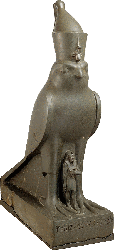
INDEPENDENT EGYPT
Plato was writing during the 62-year period in which Egypt enjoyed freedom from Persian rule. 360 BC, about the time the finishing touches were being put on the Timaeus and Critias, saw the accession of the Black Land's last native pharaoh, Snedjemibre Setepenanhur Nakhthorheb, better known as Nectanebo II.
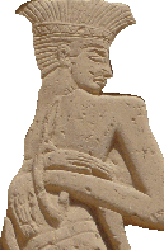
THE SEA PEOPLES WERE NOT FROM ATLANTIS
During the latter part of the New Kingdom, a powerful new antagonist emerged in the west in the form of the R'bw (Libu, hence "Libyans"), who would eventually conquer Egypt during the formative years of the first millennium BC. The rise of the Libyans as a significant foe coincides with the emergence of a variety of shadowy peoples known collectively as the "Sea Peoples."
The term "Sea Peoples" is applied to members of a total of nine or ten groups who appear in Egyptian records dating to between the 14th & 10th centuries BC. In rough chronological order of their first appearances, the individual groups, along with common identifications where given, are as follows: -
Aggressive activities by one or more of these groups are recorded as early as the Amarna period [EA 38], and the great pharaoh Ramsses II faced an attack by a group of Sherden in his second year: -
Captured Sherden from the raid were subsequently incorporated into the Egyptian military as Ramsses' personal bodyguard, and served with distinction at Kadesh against the Hittites, who numbered the Karkiša, Lukka and Drdny among their allies. The Karkiša and Lukka were, as noted, known to the later Greeks as Carians and Lycians, whilst the Drdny are Homer's Dardanoi. The Sea Peoples' first major concerted effort to invade Egypt would come in the reign of Ramsses' son and eventual successor Merneptah.
MERNEPTAH
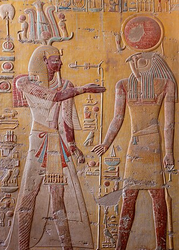
The most significant event of Merneptah's reign was his victory over a coalition of Sea Peoples acting in concert with the Libu, led by the chief Merey or Meryey. The most striking aspect of Merneptah's description states that Merey had "fallen upon the country of Tehenu with his bowmen." Tehenu, or Tjehenu, along with the slightly later term Temehu was the generic Egyptian name for their western neighbour with a pedigree dating back to the dawn of dynastic history, and Merneptah's description suggests that the Libu, first attested during the reign of his father, along with the Meshwesh (who first appear during the 18th dynasty), originated further to the west. Furthermore, the "Ekwesh, Teresh, Lukka, Sherden, Shekelesh" are described as "northerners coming from all lands," who could have been interpreted by a later Greek writer as being associated with the Etruscans (Tyrsenoi, i.e. Teresh), which Plato states was, like Libya, under the sway of Atlantis, Sardinians and Siculi.
There are problems with this theory, however. The Lukka remain transparently the inhabitants of Lycia, whilst it is difficult to imagine a later Greek hearing the name of the Eqwesh without being reminded of the Achaeans of legend. Additionally, none of the people mentioned in the Great Karnak Inscription or elsewhere coincide with the names of Poseidon's ten sons, nor is Athens mentioned as providing leadership or assistance.
RAMSSES III
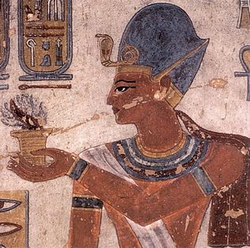
Possibly more cataclysmic were the events which marked the final collapse of the Bronze Age trading system throughout the Aegean and Near East. The Mycenaean civilisation, the Hittite Empire and Ugarit collapsed and, in many areas, material culture and political life grew increasingly impoverished. Egypt survived - barely - thanks in no small part to two major victories against the Sea Peoples: a naval battle in the Nile Delta, and another on land at Djahy. Nevertheless, by the end of the 20th Dynasty, the Levant was in the hands of the various Sea Peoples, and Egypt as a major player in the Levant was a busted flush. The Peleset settled the strip of coast around the five cities of Gaza, Ekron, Gath, Ashkelon and Ashdod, emerging as implacable foes of the nascent Israelite kingdom, and may well have bequeathed their name to a state further to the north around Tel Tayinat, whilst the Tjekker settled at Dor according to the account of Wenamun, writing at the transition between the 20th and 21st Dynasties. Additionally, the Israelite tribe of Dan, whose most renowned member was the preternaturally-strong Samson, have been posited as originating as a settlement of the Denyen, though this idea is disputed. Furthermore, the Onomasticon of Amenope places a number of these groups in the Levant. Trude and Moshe Dothan write: -
Of course, judging by the lands that Ramsses places the activities of the Sea Peoples prior to their arrival in Egypt, the major focus for this conflict was in the Levant. Additionally, the roll-call of Sea People groups involved contains, in the Denyen, a name with Homeric resonances (the Danaans). As such, there appears to be little here per se to suggest that Ramsses' account of the Sea Peoples specifically could be an influence on Plato.
One final point to note is that positing a connection between the Sea Peoples and the depredations of Atlantis requires significant reworking of the time spans given by Plato. Such gymnastics are, I believe, contrary to the point that Plato was trying to make, namely that his primitive Athens was older than the Egyptian civilisation.
A KERNEL OF TRUTH?
Nevertheless, while this writer is sceptical of the truth of the tale of Atlantis, it cannot be definitively ruled out that Plato - for all the embellishments - was working with something, a document maybe or an oral tradition, brought from Egypt either by Solon or, perhaps more likely, other Greeks who had spent time in the Nile Delta.
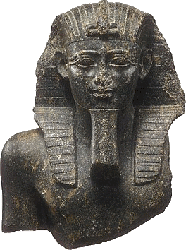
Noting that - albeit several centuries after Plato and Solon's time - Pliny the Elder claimed that Atlantia was among the former designations for "Ethiopia," it is well worth looking at the foundation of the Saïte kingdom, Psamtik I.
Psamtik I, as noted above a possible descendant of the rulers of the "24th dynasty," first comes to prominence in 665 BC as a refugee in Syria, fleeing the Kushite - i.e. Ethiopian - ruler Tantamani, whose conquest of Lower Egypt resulted in the death of Psamtik's father Necho I in battle.
A year later, Psamtik returned in triumph in the retinue of the Assyrian ruler Ashurbanipal, who conquered Memphis and Thebes, expelling the Kushites and installing Psamtik as ruler of Saïs and Memphis.
Psamtik's installation appears to have caused some religious fervour among the Egyptians, with Herodotus reporting that this invoked the ire of the other petty rulers in the region [2.151].
Finding himself once more in exile, Psamtik had the good fortune to fall in with a group of Ionian and Carian sailors, with whose aid he manage to wrest control from his enemies and become the undisputed pharaoh. Alternatively, Psamtik may have been given aid from the Aegean region after formulating an alliance with Gyges of Lydia.
Either way, if we wish to find an Egyptian account of Greeks (albeit not Athenians) aiding an Egyptian ruler in ridding himself of his enemies, we need look no further back in time than the very foundations of the dynasty of Necho II and Amasis. Add to this a poetic touch to fashion from these (Egyptian) enemies foreigners - perhaps based upon the Kushites expelled in 664 BC - as well as Athens' close ties to Saïs during Amasis' time, and we have a potential foundation upon which Plato (or, perchance, Critias) could build a new ancient Athens and its mighty primordial foe.
HOW OLD WAS EGYPT?
One final Egyptian question which concerns us is the age of Egyptian civilisation. Plato, of course, claims that Saïs was founded a thousand years after the early Athens, in around 8600 BC, whereas modern scholarship dates the rise of dynastic Egypt as a unified kingdom to a little before 3000 BC. The ancient Greeks, however, had differing views about the age of the great Nile kingdom.
MANETHO
Writing in Ptolemaic Egypt a short while after Plato, Manetho, a native Egyptian priest hailing from Sebennytos, is to be credited with the modern concept of Egyptian "dynasties." His Aegyptiaca furnishes details of thirty-one of them prior to the assumption of the Egyptian crown by Alexander the Great in 332 BC, and, while we do not have his actual writings, they were used extensively by early chronographers, with particularly complete renderings found in the works of Africanus and Eusebius. Based on the surviving dates, as given by Peter Lundström on Pharaoh.se, and treating each king as reigning sequentially (as we know was not the case in reality), we reach dates of between c.5800 and 5000 BC for the accession of "Menes," the putative founder of the Egyptian kingdom. This would place the events detailed in the Timaeus-Critias in the time of the predecessors of this first human king, details of whose reigns appear in both the Turin Canon and some notices of Manetho. The Armenian Version of Eusebius lists a dynasty of gods ending with Bydis or Bites ruling for 13,900 years (which are understood as months); then demigods for 1255 years; a third dynasty, probably Memphite, for 1817 years; thirty kings of Memphis for 1790 years; ten kings of This for 350 years; and Spirits of the Dead and Demigods for 5813 years.
HERODOTUS
More relevant perhaps to our discussion is Herodotus, who claims to have witnessed Memphite priests read out the names of 330 kings from a papyrus roll [2.100]. More specifically, he mentions a lineage of 341 generations between the first king and Sethos, a priest of Hephaestus most likely based on Shabaka or Shebitku of the 25th dynasty. Herodotus thus calculates the span of Egyptian history to extend more than 11,340 years based upon his calculation of three generations per century [2.142]. He also knows of three generations of gods, the oldest seeming to be the Ogdoad, who bore the "Twelve" 17,000 years before Amasis [2.43]. The "Twelve" then gave rise to the third generation 2,000 years later [2.145]. These latter notices accord reasonably well with Manetho, but Herodotus overextends the reigns of the human rulers (if indeed the "first king" is Menes). Plato, for his part, later claims that there are images in Egypt which are literally 10,000 years old [Laws 2.656e-657a].

